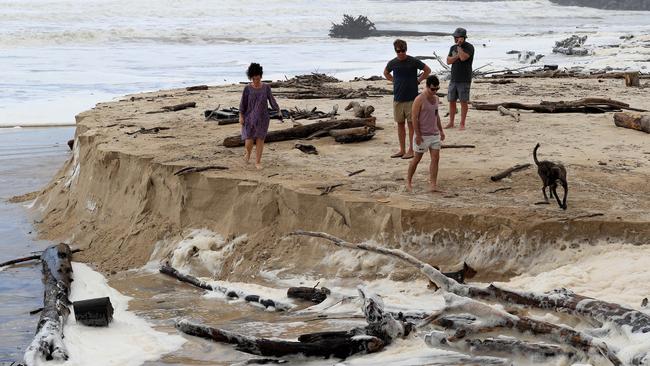Most of Queensland drought declared despite heavy rainfall
Some areas of southeast Queensland have eclipsed their rainfall totals from last year in under two months, but most of the state remains drought-declared.
QLD weather news
Don't miss out on the headlines from QLD weather news. Followed categories will be added to My News.
MORE than two-thirds of Queensland is still drought-declared, despite record-breaking rainfall, flooded rivers, full dams and overflowing rainwater tanks.
Torrential rain has smashed southeast Queensland over the past week, with some areas – including Coolangatta, Dalby, Roma and Warwick – already eclipsing their 2019 yearly totals in under two months.
But State Government officials say it is unlikely any decisions about lifting drought declarations will be made until April.
“Has this been drought-breaking rain?” Drought Commissioner Mark O’Brien said yesterday.
“Not by a long shot.’’
Residents evacuate after dam wall bursts

Experts suggest it will take another two years of decent rain and rural recovery to officially break the worst drought in 100 years.
“Nothing’s better than good flooding rain, it’s what starts the breaking of the drought,” Mr O’Brien said.
“But the bigger the drought, the bigger flood you need to break it, and then you need steady follow-up rain.
“It’ll come back, that’s the beauty of nature.’’
The news comes after Tweed Heads was declared a disaster zone following a huge downpour, 140mm of rain was dumped on the Gold Coast’s northern suburbs in just three hours on Thursday causing flash flooding, and 235mm fell on the Sunshine Coast.
State Emergency Services received more than 580 calls for help across the southeast and north coast, and 22 schools and 31 early childhood centres were closed.
But most of the state – below a line largely marked by the Flinders Highway that runs from Townsville to Mount Isa – is still emblazoned in red on drought maps. Even Brisbane and the Gold Coast – where cars have been swept away, roads are awash, and homes inundated – are still in drought.
Facebook’s Who Got The Rain group, with almost 60,000 members, would struggle “to find anyone who will say the drought is broken”, administrator Donna Midgley Paynter said.
“Even those who have had big falls will require follow-up and then another good season next year for the country to fully recover from drought,’’ she said.
“They may have good grass and full dams but the daunting task of rebuilding stock numbers with depleted funds keeps them in drought mode.
“Until they’ve rebuilt to before drought status and have money coming in they’ll consider the drought still on.”
Quilpie Shire Council CEO Dave Burges said falls of 60mm-120mm were “relief” enough this season but not drought-breaking in sheep country, with average rainfall of 200mm a year.
“It’s got to be two or three decent seasons in a row before you can call the end of the drought,’’ he said.
Stanthorpe residents are still trucking in water at a cost of $800,000 a month, as run-off trickles into the town supply at Storm King Dam.
“One rain event doesn’t break a drought,’’ Southern Downs Mayor Tracy Dobie said.
“We’ve had more rain since January than we did in all of 2019, up to about 200mm.
“But it’s patchy, and not a lot of it is falling in the catchment of Storm King Dam.’’
Local Government Association of Queensland chief Greg Hallam said the rain was welcome but had not been widespread enough.
“There are still large parts of the state, like parts of southwest Queensland and the lower Channel Country, that are in desperate need of rain,’’ he said.


